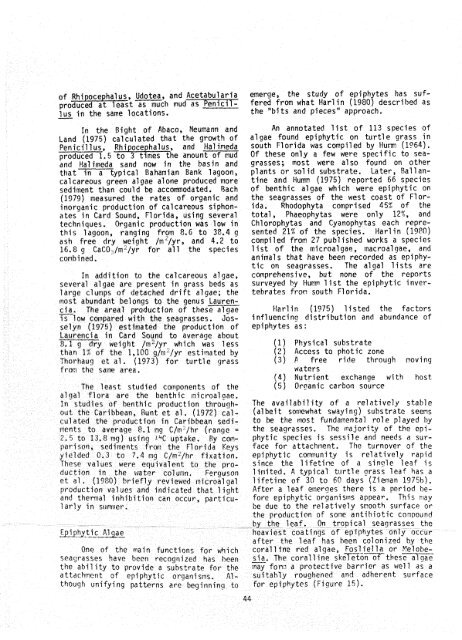The Ecology of the Seagrasses of South Florida - USGS National ...
The Ecology of the Seagrasses of South Florida - USGS National ...
The Ecology of the Seagrasses of South Florida - USGS National ...
Create successful ePaper yourself
Turn your PDF publications into a flip-book with our unique Google optimized e-Paper software.
<strong>of</strong> *- Udotea, and Acetabuf aria emerge, <strong>the</strong> study <strong>of</strong> cpiph tes has suf-<br />
Pr t as much mud as Penicil- fered from what Harlin (19803 described as<br />
lus in <strong>the</strong> same locations.<br />
<strong>the</strong> "bits and pieces" approach.<br />
Xn tine Bight <strong>of</strong> Abaco, PIeumann and An annotated list <strong>of</strong> 113 s~ecies <strong>of</strong><br />
land (19%) calculated that <strong>the</strong> growth <strong>of</strong> algae found epiphytic on turtle grass in<br />
-, and Hali~eda south <strong>Florida</strong> was compiled by Hum (1964).<br />
produced 1,s e amou Of <strong>the</strong>se only a few were specific to seaand<br />
Walimeda sand now in <strong>the</strong> basin and grasses; most were also found on o<strong>the</strong>r<br />
ttlat T3-typical Bahamian Bank lagoon, plants or sol id substrate, later, Ball ancalcareous<br />
green algae alone produced more tlne and Hum (1975) reported 66 species<br />
sediment than could be accommodatedr Bash <strong>of</strong> benthic algae which were epiphytic on<br />
(1979) measured <strong>the</strong> rates <strong>of</strong> organfc and <strong>the</strong> seagrasses <strong>of</strong> <strong>the</strong> west coast <strong>of</strong> Florinorganic<br />
production af cal careous siphon- ida. Rhodophyta comprised 45% <strong>of</strong> <strong>the</strong><br />
ntes 4n Card Sound, <strong>Florida</strong>, using several total, Phaeophytas were only 12% and<br />
techniques, &ganic production was 1 ow in Chl oroptrytas and Cyanophytas each reprethds<br />
lagoon, rangfng from &,6 to 38.4 g sented 21% <strong>of</strong> <strong>the</strong> species. Warlin (1980)<br />
ash free dry weight /mi/yr, and 4.2 to compfled from 27 published works a species<br />
16,8 g CaCO,/mi/yr Pcrr all <strong>the</strong> specles list <strong>of</strong> <strong>the</strong>! nlicroalgae, macroalqae, and<br />
conbf nad,<br />
animals that have been recorded as epiphytic<br />
on seaprasses. <strong>The</strong> algal lists are<br />
In addftian to <strong>the</strong> calcareous algae, comprehensive, but none <strong>of</strong> <strong>the</strong> reports<br />
several algae arc present In grass beds as surveyed by kHuw list <strong>the</strong> epiphytic inverlarge<br />
clumps <strong>of</strong> detached drift algae; <strong>the</strong> tebrates frnn south <strong>Florida</strong>.<br />
lirrnst abundant belongs to <strong>the</strong> genus Laur3n2<br />
cf&, Iha areal praductfon <strong>of</strong> ehesmgae llarlin (1975) If sted <strong>the</strong> factors<br />
?%*mlow coinpar& with .<strong>the</strong> <strong>Seagrasses</strong>. Jas- i nfluencing distribution and abundance <strong>of</strong><br />
sclyn (1975) est Jmiltsd <strong>the</strong> production <strong>of</strong> epiphytes as:<br />
Lauren$i&- fn Card Sound to average about<br />
WUB %I*<br />
8,1 q Z$r wcfght /tn2/yr which was less (1) Physical substrate<br />
than 1% <strong>of</strong> <strong>the</strong> J,lOO g/mJJyr estir?al& by (2) Access to photic zone<br />
Pherrharrrl et 91. (1W3) for ttirtle grass (3) F free ride tt.\rough ~ovinq<br />
fre)~:i <strong>the</strong> $d!ile area. waters<br />
(4) Nutrient exchange with host<br />
<strong>The</strong> least studied cmnponents OF <strong>the</strong> (5) Ornanic carbon source<br />
algal flora! are <strong>the</strong> benthSc nicroalpae.<br />
In stulffer <strong>of</strong>" benthic production through- <strong>The</strong> availability <strong>of</strong> a relatively stable<br />
out %he CarSbbean, Runt et nl. (1971) gal- (albej t somewhat swaying) substrate seens<br />
c:ulatatd <strong>the</strong> productSon in Caribbean r,@di- d0 be <strong>the</strong> most fundamental sole played by<br />
flarpfll~ f;O average 8.1 rrg C/mt/hr (range = <strong>the</strong> seagrasses. Thc majority <strong>of</strong> <strong>the</strong> epi-<br />
2,5 to 13*8 mg) igsivlg uptake. Py cop\- phytic species js sessile and needs a surjrdrfson,<br />
sedlrnentr; frorn <strong>the</strong> Ff ar-ida Keys face far attachnent. <strong>The</strong> turnover <strong>of</strong> <strong>the</strong><br />
yff?lde?d 0*3 t0 7,4 rng C/mZ'/hr Fixation, cpiphyejc cmunity is relatively rapid<br />
<strong>The</strong>se vl;xlucs were ~q~iv~lent to <strong>the</strong> pro- since <strong>the</strong> lifetit~c <strong>of</strong> a sinqle leaf is<br />
L~1~tSt~lvl 4n <strong>the</strong> vcStter colug;;rn, ferguson lialited. A typical turtle Grass leaf has a<br />
@t $1. (19C05 hricnfly reviet~cd rsicroatgal lifetime <strong>of</strong> 30 to 60 days (Xienan 197%).<br />
produckfon valucs and fndjcatcd that light After a leaf cmcrqes <strong>the</strong>re is a period heand<br />
<strong>the</strong>mal Snhibf tion occur, particu- fore epiphytic organisms appear. This nay<br />
7 arfy in stimfiicr. be due to <strong>the</strong> relatively svoot6 surface or<br />
<strong>the</strong> producticn <strong>of</strong> sane antihistic colnpound<br />
by <strong>the</strong> leaf. On tropical seagrasses <strong>the</strong><br />
&9J2!y>J~&a2<br />
heaviest coatings af epiphytes only occur<br />
after <strong>the</strong> leaf has heen colonized by <strong>the</strong><br />
One <strong>of</strong> <strong>the</strong> main functions far &i@h coral l fne red algae, Fos1 fe11ii or -- !?elah@-<br />
%ca$grW3SS@s have been recognir~d has he@~ G. <strong>The</strong> caral'line sk~Teton <strong>of</strong> thcse algae<br />
<strong>the</strong> ahil ity to provlde a substrate for <strong>the</strong> may fom a protective barrier as well as a<br />
attachment <strong>of</strong> epiphytic organisms, Al- sui tahly roughened and adherent sttrface<br />
thnuqh unffyirtg patterns arc beginning to for epiphytes (Figure 15).<br />
44

















